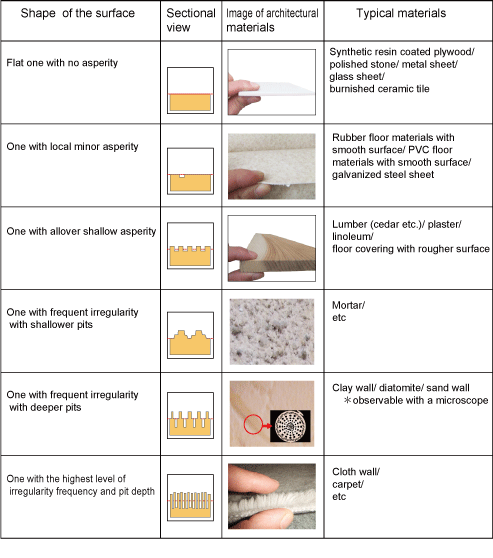2.3 Where? “Knowledge of architectural materials” / What kind? “Knowledge of dirt”
The Equation of Cleaning: The analysis of present condition to determine cleaning technique

Before we start cleaning, we need to first analyze what kind of dirt is attached to where. Then, we can decide on a technique based on the result of the analysis.
Analyze the location and the disposition of dirt. Since house dirt attaches to architectural materials, we need to understand where the dirt attaches to (knowledge of architectural materials) and what kind of dirt it is in order to arrive at the effective technique.

2.3-1 Knowledge of architectural materials (Where?)

Dirt in houses attaches to architectural materials such as floors, walls, and furniture. To remove the dirt, knowledge on materials such as their types, chemical dispositions, and physical dispositions is essential. Basic issues that need to be examined include “the type of architectural materials and their location”, “water resistance and detergent resistance”, “surface configuration and hardness”, and “water absorbability and hygroscopicity.”
★ Where? Steps for analyzing architectural materials
(1) Examine “the type of architectural materials and their location” (2) Examine chemical disposition such as “water resistance and detergent resistance” (3) Examine physical disposition such as “surface configuration and hardness” and “water absorbability and hygroscopicity.”
(1) Examine “the type of architectural materials and their location”
Recently, more diversity and complexity is seen in types of architectural materials, which makes it difficult to make a snap judgment. Therefore, we need to consider it as a prerequisite to check the type of architectural materials and their locations.

With respect to the examination of the location, even if the same dirt is attached to the same materials, we have to employ different techniques according to where the material is used, i.e. floors, walls, and ceilings. Hence it is necessary to check the location as well.
★ For example…Some types of materials do not allow the use of certain detergents and tools. Hence, it is very important to know what kind of architectural materials the dirt is attached to. Where the materials are used is a no less important factor since it greatly influences the technical methods. Liquid detergents, which have no problem to be used on a floor, have to be replaced by frothy detergents if dirt is on a wall or a ceiling. Another reason why it is important to check where the materials are used is that when dirt is on a ceiling or on a higher part of a wall we need to prepare tools for high-place work and take care of safety measures.
(2) Examine “water resistance and detergent resistance”: chemical disposition
The vital point concerning the understanding of materials to which dirt is attached are chemical dispositions such as water resistance and detergent resistance. Water and detergent are indispensable in cleaning and, therefore, requires more familiarity on our side. It is crucial to check if the architectural materials absorb water (hydrophilia) or repel water (oleophilia). To know if the material is staticky, another chemical disposition is also important. Such understanding of chemical disposition leads us to the facts below.

Some detergents are not to be used for certain types of architectural materials. Lack of such knowledge may result in some serious damage. Hence it is important to know detergent resistance of architectural materials.
★ For example… detergents with strong acidity dissolve concrete and mortar through chemical reaction. Thinner sometimes dissolves plastic materials gradually over time after the use.
(3) “Surface configuration and hardness” and “water absorbability and hygroscopicity” : physical disposition
Physical disposition of architectural materials influences the way to clean up dirt. Even with the same detergent, you could damage architectural materials or end up only spreading dirt out if you are unaware of materials’ physical disposition. Materials with rough surface are hard to work with and soft materials are vulnerable to damage. Moreover, materials that absorb water hold up wet dirt inside and make it difficult to remove it. To put it short, cleaning technique should be in accordance with materials’ physical disposition.
1) Examine surface configuration and hardness
Flat and solid surface tends to keep off dirt and is easy to clean when it has got dirty. Rough and lacunal surface attracts dirt and is hard to clean.

A Close examination of architectural materials, particularly with a microscope, reveals the diversity of superficial configuration. Since “roughness” is surely not a sufficient indicator, we need to take into account the “frequency of asperity” and the “form of asperity”. For instance, even with the same frequency of asperity, one with sharper or more complicated projection and depression gets dirtier and is harder to clean.
In the following, I categorized basic architectural materials according to their “roughness.”

Not only superficial configuration but also hardness of architectural materials should be considered in determining the cleaning method. Soft materials and hard ones require different technique.
2) Examine water absorbability and hygroscopicity: physical disposition
Materials that absorb water or moisture are susceptible to penetration by dirt mixed in water and hard to clean. Hence, considerable attention should be paid when using water and detergents. A porous or spongy material draws in dirt dissolved in water by capillary action even though the material itself does not absorb water.
1Capillary action means liquid moves up (in some cases, down) inside a narrow tube-formed materials
2Porous or spongy architectural materials have gaps (pores) that catch fluid by capillary action and the power to catch fluid can be figured out from the number of pores. Majority of humidity control materials use this mechanism.
★The picture shows diatomite, one of materials used for walls. If you examine the surface with a microscope, you will see that the material is porous with a number of small bumps, meaning it absorbs moisture. Architectural materials with humidity conditioning effect often have these small bumps.

NEXT

